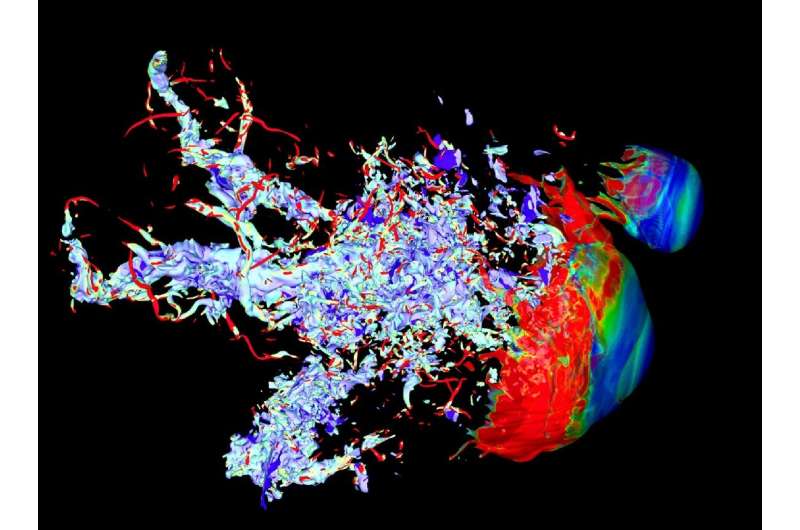Scientists describe the collision of a shockwave and a 'star cradle'

A mathematician from MSU together with a Russian colleague modeled the formation of filaments (thread-like matter conglomerates) after the collision of a shockwave with molecular clouds in interstellar space. The work will help the scientists better understand the birth of stars and star systems. The results of the study were published in Computers and Fluids magazine.
The authors considered the situation of a shockwave from a supernova explosion reaching molecular clouds—interstellar matter conglomerates with high density. Giant molecular clouds are also known as "star cradles," as new stars are formed there. A shockwave moves at supersonic speed and changes the structure of the cloud, shaping high- and low-density areas and thread-like structures called filaments. Along with this, the collision puts flows of matter into motion and bends their trajectories, causing swirls at the external borders of the cloud. This phenomenon is known as the Richtmyer-Meshkov instability. The modeling of such collisions is complicated, as there are several complex processes going on simultaneously.
The scientists suggested a model that describes the formation of a matter swirl and filaments after the passing of the shockwave. They have considered the influence of density distribution along the radius and the shapes of the clouds on the process of interaction between a shockwave and molecular clouds, as well as the occurrence and redistribution of matter flows, shaping of filaments, and, as a result, formation of high density areas.
"A 3-D calculation program has been developed, fine-tuned, and tested in order to mathematically model the processes of interaction in molecular clouds during collisions and possible formation of new stars and star systems," explained Boris Rybakin, Professor of the Faculty of Mechanics and Mathematics, MSU.
The model consists of over 4 billion computational nodes. To reduce the processing time for such huge amounts of data, the scientists used parallel calculations, working with different groups of data independently at the same time.
The modeling showed that the formation of filaments and irregularities of density distribution depended primarily on the compression of the cloud's matter under the impact of the shockwave. It also helped identify three phases of collision. In the first stage, swirl structures formed behind the wave front; in the second stage, once the shockwave spreads, Richtmyer-Meshkov instability forms, and the flows of matter on the borders of the cloud speed up. In the last stage, the filaments occur in high-density areas, and very dense protostars are formed.
The authors of the article believe that further use and improvement of the model may help understand how stars and star systems are born in dense areas of molecular clouds. "Recently obtained data shows that the process of star formation in our galaxy is slowing down. Only several stars are born each year, while the matter is enough for several hundreds. On the other hands, in some of the recently discovered galaxies, this process is very intense," added Boris Rybakin.
The study was conducted together with a colleague from Tver State Technical University.
More information: Boris Rybakin et al, Modeling of density stratification and filamentous structure formation in molecular clouds after shock wave collision, Computers & Fluids (2018). DOI: 10.1016/j.compfluid.2018.03.009
Provided by Lomonosov Moscow State University





















